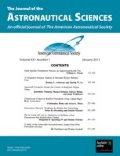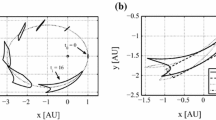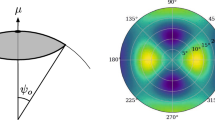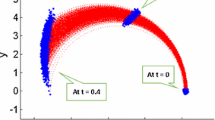Abstract
This paper demonstrates the use of generalized polynomial chaos expansion for the propagation of uncertainties present in various dynamical models. Specifically, a sampling based non-intrusive approach using pseudospectral stochastic collocation is employed to obtain the coefficients required for the generalized polynomial chaos expansion. Various recently developed quadrature techniques are employed within the generalized polynomial chaos expansion framework in order to illustrate their efficacy. In addition to that, the paper also provides an efficient numerical quadrature technique to be used as a sampling technique in stochastic collocation to quantify the uncertainties which are governed by different distribution functions. Results are presented for the orbital motion of a 2U CubeSat subject to initial condition uncertainty and drag related parametric uncertainty demonstrating the accuracy and effectiveness of the proposed technique. Further, stochastic sensitivity analysis is performed to gain insight into the impact of uncertain variables on the evolution of the quantities of interest.











Similar content being viewed by others
References
Sauer, T.: Numerical solution of stochastic differential equations in finance. In: Handbook of Computational Finance, pp. 529–550. Springer (2012)
Fishman, G.: Monte Carlo: Concepts, Algorithms, and Applications. Springer Science & Business Media (2013)
Duan, J.: An Introduction to Stochastic Dynamics, vol. 51. Cambridge University Press (2015)
Gao, T., Duan, J., Li, X.: Fokker–planck equations for stochastic dynamical systems with symmetric Lévy motions. Appl. Math. Comput. 278, 1–20 (2016)
Sudret, B.: Uncertainty propagation and sensitivity analysis in mechanical models–contributions to structural reliability and stochastic spectral methods. Habilitationa diriger des recherches. Université Blaise Pascal, Clermont-Ferrand (2007)
Zhang, D.: Stochastic Methods for Flow in Porous Media: Coping with Uncertainties. Elsevier (2001)
Wiener, N.: The homogeneous chaos. Am. J. Math. 60(4), 897–936 (1938)
Xiu, D.: Numerical Methods for Stochastic Computations: A Spectral Method Approach. Princeton university press (2010)
Ghanem, R.G., Spanos, P.D.: Stochastic finite element method: Response statistics. In: Stochastic Finite Elements: A Spectral Approach, pp. 101–119. Springer (1991)
Xiu, D., Hesthaven, J.S: High-order collocation methods for differential equations with random inputs. SIAM J. Sci. Comput. 27(3), 1118–1139 (2005)
Stroud, A. H, Secrest, D.: Gaussian Quadrature Formulas. Prentice-Hall Series in Automatic Computation. Prentice-Hall, Englewood Cliffs (1966)
Smolyak, S.A.: Quadrature and interpolation formulas for tensor products of certain classes of functions. Dokl. Akad Nauk SSSR 148(5), 1042–1045 (1963)
Congedo, P.M., Abgrall, R., Geraci, G.: On the use of the Sparse Grid techniques coupled with Polynomial Chaos. Research Report RR-7579, INRIA (2011)
Jones, B.A., Doostan, A., Born, G.H.: Nonlinear propagation of orbit uncertainty using non-intrusive polynomial chaos. J. Guid. Control Dyn. 36(2), 430–444 (2013)
Dell’Elce, L., Kerschen, G.: Probabilistic assessment of lifetime of low-earth-orbit spacecraft: uncertainty propagation and sensitivity analysis. J. Guid. Control Dyn. 38(5), 886–899 (2014)
Adurthi, N., Singla, P., Singh, T.: Conjugate unscented transformation: Applications to estimation and control. J. Dyn. Syst. Measur. Control 140(3), 030907 (2018)
Madankan, R., Singla, P., Singh, T.: Application of conjugate unscented transform in source parameters estimation. In: American Control Conference (ACC), pp. 2448–2453. IEEE (2013)
Fisher, J.R.: Stability analysis and control of stochastic dynamic systems using polynomial chaos, PhD thesis (2008)
Xiu, D., Karniadakis, G.E.: The wiener–askey polynomial chaos for stochastic differential equations. SIAM J. Sci. Comput. 24(2), 619–644 (2002)
Bhusal, R., Subbarao, K.: Uncertainty quantification using generalized polynomial chaos expansion for nonlinear dynamical systems with mixed state and parameter uncertainties. J. Comput. Nonlin. Dyn. 14(2), 021011 (2019)
Desai, A., Sarkar, S.: Analysis of a nonlinear aeroelastic system with parametric uncertainties using polynomial chaos expansion. Math. Probl. Eng., 2010 (2010)
Sudret, B.: Global sensitivity analysis using polynomial chaos expansions. Reliab. Eng. Syst. Safety 93(7), 964–979 (2008)
Sobol, I.M.: Sensitivity estimates for nonlinear mathematical models. Math. Modell. Comput. Exper. 1(4), 407–414 (1993)
Heiss, F., Winschel, V.: Likelihood approximation by numerical integration on sparse grids. J. Econ. 144(1), 62–80 (2008)
Wasilkowski, G.W., Wozniakowski, H.: Explicit cost bounds of algorithms for multivariate tensor product problems. J. Complex. 11(1), 1–56 (1995)
Jia, B., Xin, M., Cheng, Y.: Sparse gauss-hermite quadrature filter with application to spacecraft attitude estimation. J. Guid. Control Dyn. 34(2), 367–379 (2011)
Julier, S.J., Uhlmann, J.K.: New extension of the Kalman filter to nonlinear systems. In: Signal Processing, Sensor Fusion, and Target Recognition VI, vol. 3068, pp. 182–194. International Society for Optics and Photonics (1997)
Stroud, A.H.: Some fifth degree integration formulas for symmetric regions. Math. Comput. 20(93), 90–97 (1966)
Stroud, A.H.: Some seventh degree integration formulas for symmetric regions. SIAM J. Numer. Anal. 4(1), 37–44 (1967)
Jia, B., Xin, M., Cheng, Y.: High-degree cubature Kalman filter. Automatica 49(2), 510–518 (2013)
Rosenbrock, H.H.: An automatic method for finding the greatest or least value of a function. Comput. J. 3(3), 175–184 (1960)
Eldred, M., Webster, C., Constantine, P.: Evaluation of non-intrusive approaches for wiener-askey generalized polynomial chaos. In: 49th AIAA/ASME/ASCE/AHS/ASC Structures, Structural Dynamics, and Materials Conference, 16th AIAA/ASME/AHS Adaptive Structures Conference, 10th AIAA Non-Deterministic Approaches Conference, 9th AIAA Gossamer Spacecraft Forum, 4th AIAA Multidisciplinary Design Optimization Specialists Conference, p. 1892 (2008)
Jones, B.A., Bryant, D.S., Vo, B.-T., Vo, B.-N.: Challenges of multi-target tracking for space situational awareness. In: 18th International Conference on Information Fusion (FUSION), pp. 1278–1285. IEEE (2015)
Gottlieb, R.G.: Fast gravity, gravity partials, normalized gravity, gravity gradient torque and magnetic field: Derivation, code and data. NASA Contractor Report 188243 (1993)
Tapley, B, Ries, J, Bettadpur, S, Chambers, D, Cheng, M, Condi, F, Gunter, B, Kang, P, Nagel, R, et al.: Pastor Ggm02–an improved earth gravity field model from grace. J. Geod. 79(8), 467–478 (2005)
Curtis, H.D: Orbital Mechanics for Engineering Students, pp. 659–660 Butterworth-Heinemann (2013)
Hill Peter, D.: Kernel estimation of a distribution function. Commun. Statist.-Theory Methods 14(3), 605–620 (1985)
Scheeres, D.J., Hsiao, F.-Y., Park, R.S., Villac, B.F., Maruskin, J.M.: Fundamental limits on spacecraft orbit uncertainty and distribution propagation. J. Astronaut. Sci. 54(3-4), 505–523 (2006)
Kullback, S., Leibler, R.A.: On information and sufficiency. Ann. Math. Stat. 22(1), 79–86 (1951)
Petras, K.: On the smolyak cubature error for analytic functions. Adv. Comput. Math. 12(1), 71–93 (2000)
Doornbos, E.: Thermospheric Density and Wind Determination from Satellite Dynamics. Springer Science & Business Media (2012)
Moe, K., Moe, M.M., Doornbos, E.: Outstanding issues related to thermospheric measurements and modelling. In: 38th COSPAR Scientific Assembly, vol. 38, p. 4 (2010)
Author information
Authors and Affiliations
Corresponding author
Additional information
Publisher’s Note
Springer Nature remains neutral with regard to jurisdictional claims in published maps and institutional affiliations.
Rights and permissions
About this article
Cite this article
Bhusal, R., Subbarao, K. Generalized Polynomial Chaos Expansion Approach for Uncertainty Quantification in Small Satellite Orbital Debris Problems. J Astronaut Sci 67, 225–253 (2020). https://doi.org/10.1007/s40295-019-00176-1
Published:
Issue Date:
DOI: https://doi.org/10.1007/s40295-019-00176-1




